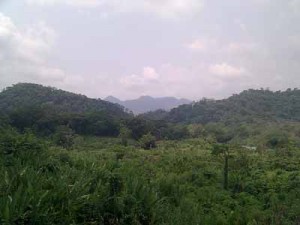
The dramatic, forested hills of Chiapas, South Mexico
I am just leaving Mexico after two months here, and on now on my way back to Guatemala, from where I will head further into Central America for the last two months of my trip. In Mexico I spent one month as a tourist heading around Cancun and the Yucatan Peninsular, and then up through the key state capitals of Oaxaca, Puebla and Mexico City. The other month has been entirely in the state of Chiapas, which borders onto Guatemala in the South. Chiapas shares with Guatemala a part rainforest environment, and a very strong presence of indigenous people – roughly a third of its population. Thanks to ENCA, on arriving in Chiapas I was able to wrangle my way onto a two week observer mission to an indigenous community supported by the famous Zapatista revolutionary army, where I stayed with several Zapatistas and helped with the work in their collective farm land. Since 1994 the Zapatistas have been fighting for their autonomy and rights against the corrupt Mexican government and army. The last two weeks have been an inspiring opportunity to learn the history of Chiapas and the Zapatistas, see the incredible strides they have made in their struggle, and see inside the reality of what this resistance means today.
Collectively, the indigenous of Southern Mexico and Guatemala are almost entirely Mayan. However, they are not a homogenous group, but many different indigenous groups with some 12 separate languages spoken between them just in Chiapas. The Mayans have a strong history of fighting for their collective identity. Since 1994 especially, the Chiapan indigenous have been demanding international attention, in the form of the Zapatista struggle for indigenous rights and autonomy. I arrived in Chiapas with a vague notion of trying to learn more about the Zapatistas, another face of the diverse swirl of social revolutionary movements that is encountered across the wider region and includes the Cuban communist revolution and Sandinistas of Nicaragua.
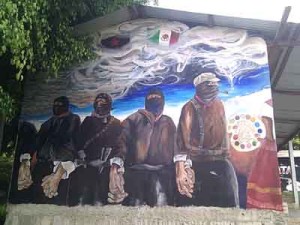
In the regional headquarters of the Zapatistas, one of the beautiful murals shows the revolutionary spirit of the movement
In the city of San Cristobal de las Casas I visited “Frayba”, the Fray Bartolome AC Human Rights Centre, who have represented indigenous struggles for human rights since before the appearance of the Zapatistas. I discovered that they now have close links with Zapatista communities, sending brigades of volunteers to “observe” in communities which are under threat of eviction or human rights violations by pro-government forces including the army. ENCA was able to provide me with the backing Frayba requested of a concerned organisation, and – not quite believing my luck – I was able to get onto one of these brigades at short notice. Frayba sent me with a few other volunteers for two weeks to a community in Agua Clara, at the edge of the most beautiful aquamarine river I have ever seen, to act as a potential deterrent from recent movement by the Mexican army to take the occupied land.
Mexico and the Maya Through History
Before arriving in Mexico the only idea I had of Mayans was the ancient race that the Spanish conquistadors encountered in the 1500s alongside the Aztecs – stepped pyramids, human sacrifices and ultimately destruction and death by Spanish horses, steel
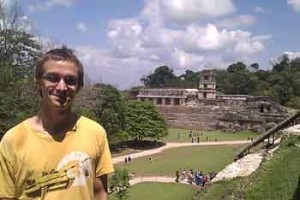
The ancient Mayan ruins at Palenque are the most impressive I’ve visited, and date from 600-900AD
and germs. I had no idea how alive indigenous culture remains – still Mayan in the South despite the deaths of the dynasties that ruled in pre-Colombian times. I visited some of the famous ancient archaeological sites such as Palenque, Tulúm and Chichén-Itzá – cities long abandoned even when the Spanish arrived. The Mayans encountered by the Spanish lived in smaller communities but remained a powerful force, and when Emeliano Zapata marched in the Mexican Revolution from 1910-1917 the Chiapan indigenous were an important part of the army behind him.
The Mexican revolution was principally to overthrow the 35 year dictatorship of Porfirio Diaz, however Zapata was among the revolutionaries whose aims went beyond power. His group represented the fight for land for the peasantry, and for legal structures to stop years of the rich tricking the poor out of the land that was their livelihood. His call was “The land is not for sale – it is for those who work it”, and following the revolution, the new 1917 Mexican constitution enshrined this principle in the unique “ejido” system of land ownership. Campesinos (the rural working class in Latin America) who had redistributed ejido land were to own it communally, and constitutionally it could not be sold, only pass from one owner to their children.
NAFTA – the Modern Face of Mexican Economics

Another mural, at Agua Clara, shows Emeliano Zapata and proclaims; “The land is not for sale – it is of those who work it”
On January 1st 1994, Mexico signed the North American Free Trade Agreement NAFTA, exposing Mexico’s developing economy to US and Canadian markets and neoliberal principles. The president at the time, Carlos Salinas, announced that “Mexico is ready to join the first world”. In the busy background preparation for NAFTA, the constitutional protection for unsellable ejido land was quietly removed, so that the big business interests that were to drive Mexico’s macroeconomic leap forward would be able to buy the land containing the resources or road-routes they were to develop. In a swoop, state protection for the interests of the poor, indigenous and campesinos – the most progressive acheivment of a 7 year revolution – was dismantled in favour of strict capitalist logic.
Neoliberalism in Mexico means – just as it does in Central America – reducing regulations and taxes on big businesses to encourage investment in the country. Its logic ignores the fact that – especially in developing countries with persistent poverty and many opportunities for capitalist exploitation – large scale investment without taxes and regulations simply concentrates the wealth in the pockets of a few beneficiaries. For the poor, it means land bought to be exploited at cut prices – through methods that cut jobs and cut wages. Land that can feed families is converted
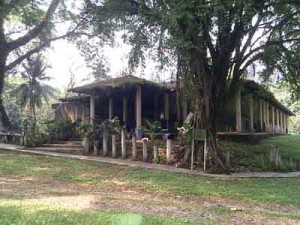
The hotel at the centre of the Agua Clara Zapatista territory
into dollars that flow out of the country. NAFTA, by exposing them to the more powerful markets to the North with whom they cannot complete, has forced Mexican campesinos into destitution. Dislocated workers that have flowed to the cities to find jobs have only found free trade zones where employment rights are removed as barriers to investment. ,Meanwhile, Mexico’s natural resources have been opened up for extraction by foreign companies at cut prices, and social services for the poor have been axed by governments trying to recuperate the money they no longer get from taxes.
In response to this and years of erosions of their rights, the new Zapatistas rose up on the day of the signing of NAFTA to say, “Enough is enough” – that Mexico was not ready to join the first world as long as it remained a country full of poverty, inequality and underdevelopment. That its corrupt democracy – which had maintained a single party, the PRI, in power constantly since 1917 – lacked the will or power to stop the harmful effects of reduced regulation under NAFTA.
The first move of the Zapatistas was an armed uprising which took over 6 Chiapan cities, including San Cristobal, on the first day. However, the military counter-attack of the next 12 days swiftly pushed back the revolutionaries, with many deaths. Frayba was a part of the work to find a ceasefire. Since then the Zapatistas have worked to form parallel systems of governance in the areas where they are strong enough – alternatives to the state and national political system that has yet to find a space to represent them.
The Zapatistas – New Indigenous and Autonomous Spaces
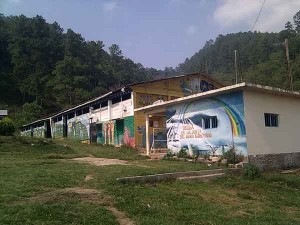
The regional Caracol at Morelia is a community in itself, and with its many murals emanates a feeling of tranquility and self-control
Since day one of their struggle, the Zapatistas have become famous for the eloquent manner with which they’ve communicated their plans and point of view, maintaining a level of global attention and support. The Zapatista’s demands vocalise the call for the Mexican government to recognise and value its indigenous peoples. As I was realising in my trip through Mexico, the indigenous are not a tiny special interest group but a large slice of the population. However, since colonialisation they have been marginalised by the rich and powerful interests that have ruled the country, and this is no less true now under neoliberalism and NAFTA that it was 500 years ago. The poverty and underdevelopment of indigenous areas speak volumes about what place the indigenous have in the plans of the neoliberal architects of Mexico’s economy.
The first two nights of our Frayba observer trip, we stayed at the regional Zapatista headquarters, the “Caracol” in the town of Morelia. The Zapatistas true successes have been their ability to create a parallel system of autonomous democratic governance, laws and services in their regions, which outsiders get a flavour of in the Caracols. There, the Zapatista “Councils of Good Governance” organise regional affairs such as rotas of guards and volunteers for local services, and resolve disputes.
However, the really amazing work is done on a more local municipality level, where Zapatista councils manage autonomous public services, in parallel to those provided by the “official” government. The Zapatista struggle has become one to reclaim their own space and develop themselves without any government support, while preventing the loss of the land which is the resource they rely on to live. On land under threat from being sold to outside interests or occupied by the military, the Zapatistas continue to act as an armed force to take and hold it for ejido style collectives. Risks of land snatches and violence by military and paramilitary forces keep Frayba involved sending its observers to put off human rights abuses and monitor anything that does happen.
Agua Clara – Contested but Still Unspoilt
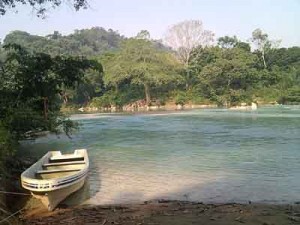
A view of the incredible, painted-blue river at Agua Clara
Agua Clara, where I stayed two weeks, is a perfect example of what the Zapatistas are protecting. The land next to the beautiful calm blue-green river that gives it its name contains an old hotel build before 1994 by a powerful land owner who left the area after the Zapatista uprising. A little upstream is Agua Azul, where Frayba have revealed corrupt deals between the state governor and big businesses to develop a mega tourism project that is now being resisted by other Zapatista communities. Five years ago the PRI supporters at Agua Clara started dividing the land around the hotel to sell it off. The Zapatistas saw the threat of exploitation similar to at Agua Azul, and occupied the hotel and contended land around it. Since then it has a constant rotation of guards from the wider Zapatista area to prevent the authorities from taking it back, and regular observers from Frayba.
The two weeks in Agua Clara passed peacefully, with no hint of problems – representing a successful trip in terms of protecting against threats, and an opportunity to enjoy the incredible setting unmolested. More than anything, it was a fantastic opportunity to talk and work a little with the people there, Zapatistas who were part of the community controlling the land, and those from elsewhere on the guard shifts. Many had been a part of the Zapatista struggle since 1994, their whole adult life.
Zapatista Reality and Strides in Autonomous Organisation

Me attempting to be a campesino, carrying firewood with a head-strap. It hurt a lot, but was a fracion of what the people there carry!
The person we had most contact with had moved there to guard the area for the Zapatistas and started a family over the last five years. He had his own reclaimed land for planting, and most of what his family ate was from this land, though they had to buy extra maize yearly to cover their needs. As well as working this land, he also took part in work on collective land owned by all the Zapatista members of the community, where they raise cattle and African palm (a hang over from the previous owners) as sources of money. This income is essential mainly for transport costs – each trip to the Caracol for meetings or training takes hours and costs some 100 pesos – as well as for emergency medications and so on. Staying nearby, I was able to share a bit of work with him and the collective. He showed me how he sows the maize seeds, in time for the imminent rainy season. Then, I spent a couple of days on the much harder work of cutting heavy and spiked bunches of African palm fruit and carrying them to be collected by a truck, practicing my machetying skills while getting thoroughly bitten by ants.
It was clear seeing the Zapatistas’ work – both for their own production and collectively – that they knew how to live for themselves, as long as they have the land to do so. The Zapatista struggle secured this for them, enabling them to live dependent on nobody for handouts. This freedom and independence is not something idyllic and carefree, but is simply practical and hardworking, and demonstrates the force and logic behind the indigenous’ fight for recognition as people with their own rights and way of life.
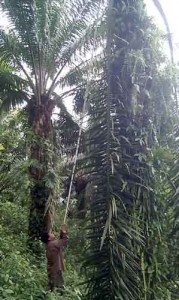
Cutting African palm requires careful use of a very long-handled knife that I could hardly carry
Later on, I talked to one of the guards at the hotel, who told me that he also works in an autonomous Zapatista school in his community as an education promoter. According to the regulations agreed among them in their local autonomous municipality, the Zapatista children have 5 days mandatory education per week, in a local school with no transport costs and classes in indigenous languages as well as Spanish. As such they now have access to the education that their parents have never been able to have. The teachers, such as the guard I talked to, have their own land for their food, but the community provides people to work their land for them during the extensive hours they donate.
Meanwhile, the community also has health promoters that provide medical care, and production promoters to improve farming methods. All Zapatistas – again according to internal agreements – farm without the use of chemicals, knowing well the environmental and health cost and dependence these bring. The production promoters help them secure organic registration for their products, which enables the guard I talked to and his local collective to sell their cafe at 100 pesos per kilo, instead of an unstable regular coffee price alternating between 25 and 40 pesos. Among all these forms of autonomous organisation, the benefits that the Zapatista struggle have bought to those involved was clear. It became clearer and clearer to me that the autonomy and respect they are struggling for is something they simply deserve – through their actions they have demonstrated their capacity to live in a better way than that prescribed by the government or the imbalanced logic of international capitalism.
Conclusion – The International Call of the Zapatistas
Talking to another one of the guards taking their turn at the hotel, we saw the determination that has inspired people internationally in the Zapatista communiques. This older guard admitted he’d had very little education, but had his own ejido land where he too grew food for his family. He described his readiness to fight the vastly better armed Mexican military if they tried to attack the Zapatista bases and community. “Who knows if we’ll win or not”, he said, but he knew that the country, and the world, are full of people who know and dislike the president, the corruption and the military that protects it, and he doesn’t think the military will be able to win against all of them. The Zapatistas know they’re up against powerful forces, but they know the advantages gained through their autonomy, and they know they’re not alone in the world, not by a long way.
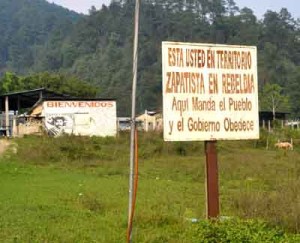
The Zapatistas mark their territory with defiant signs such as this one; “Here the people demand and the government obeys”
The indigenous campesino voice of the Zapatistas proclaims its autonomy from the corrupt politicians and neoliberal capitalists trying to run them over and exploit them. Coming to Chiapas, you see the power of this voice, that says that they won’t and don’t have to succumb to land, jobs, rights and respect being taken from them, and being left to feed themselves on the crumbs of capitalist “development”. They say that they won’t submit to the global machine of neoliberalism behind this, and to me, their statement and their stand is an inspiring source of hope for everyone else in the world. For all that it works to expand and consolidate its power, the global machine of neoliberalism is not all powerful and people are resisting it. With a combination of determination, ideology and organised solidarity, new alternative spaces can be made that provide what the capitalist system says only macroeconomic development gives, and that provide it on a locally respectful scale without forgetting or exploiting the poorest.
I’ve never had quite such an inspiring experience as I did in 2 weeks in Agua Clara. The indigenous Maya, Zapatista voice is alive in Chiapas and is an incredibly important one with a lot to teach to the rest of the world, about how to live for yourself, but especially how to resist the exploitation within international capitalism.
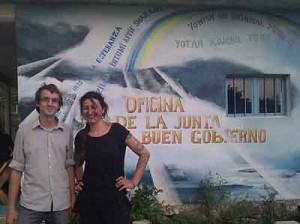
Me and a fellow observer at the Caracol’s “Council of Good Government” after the trip
